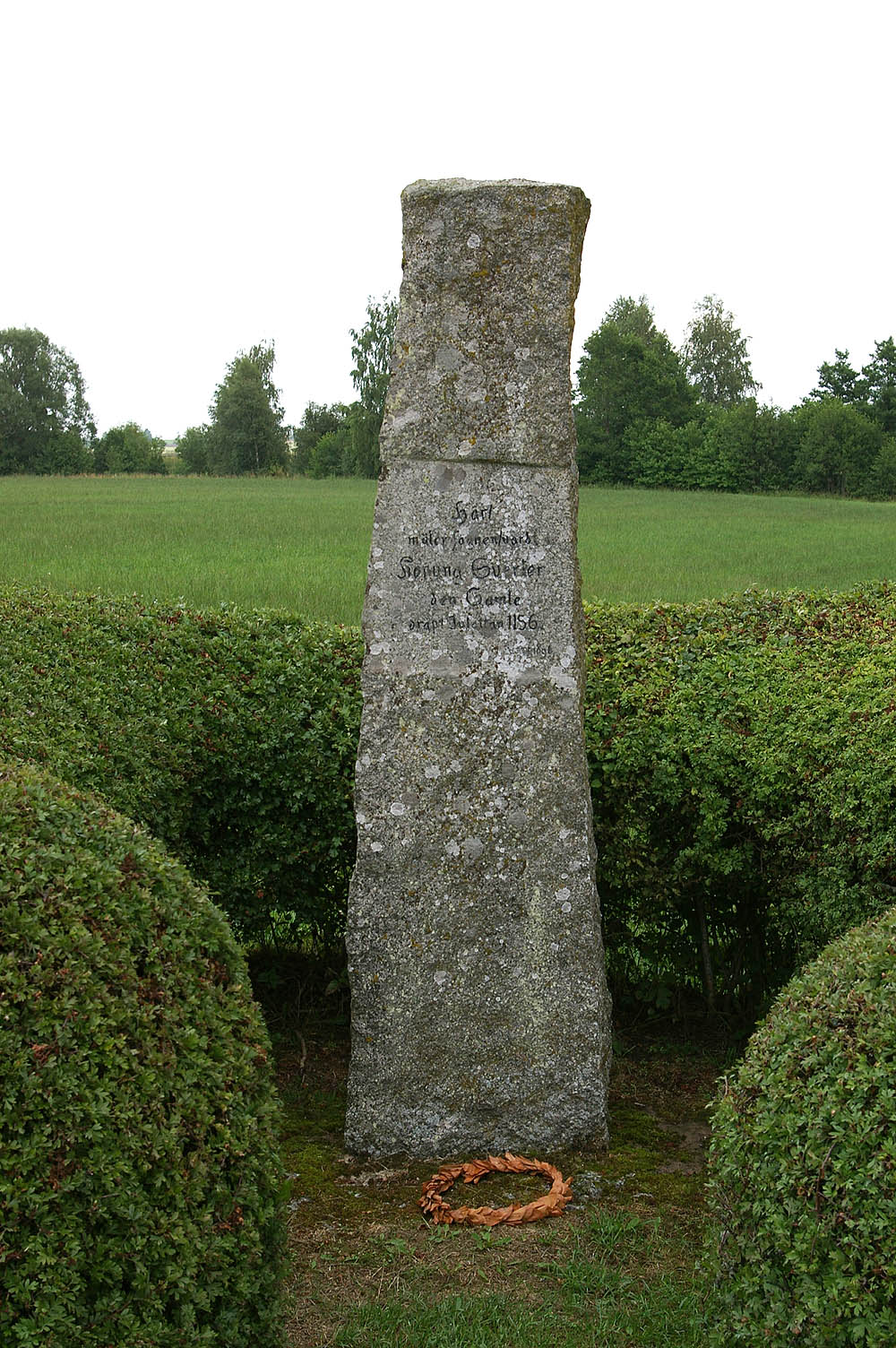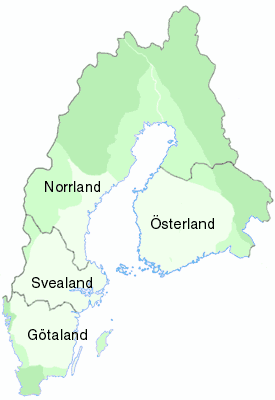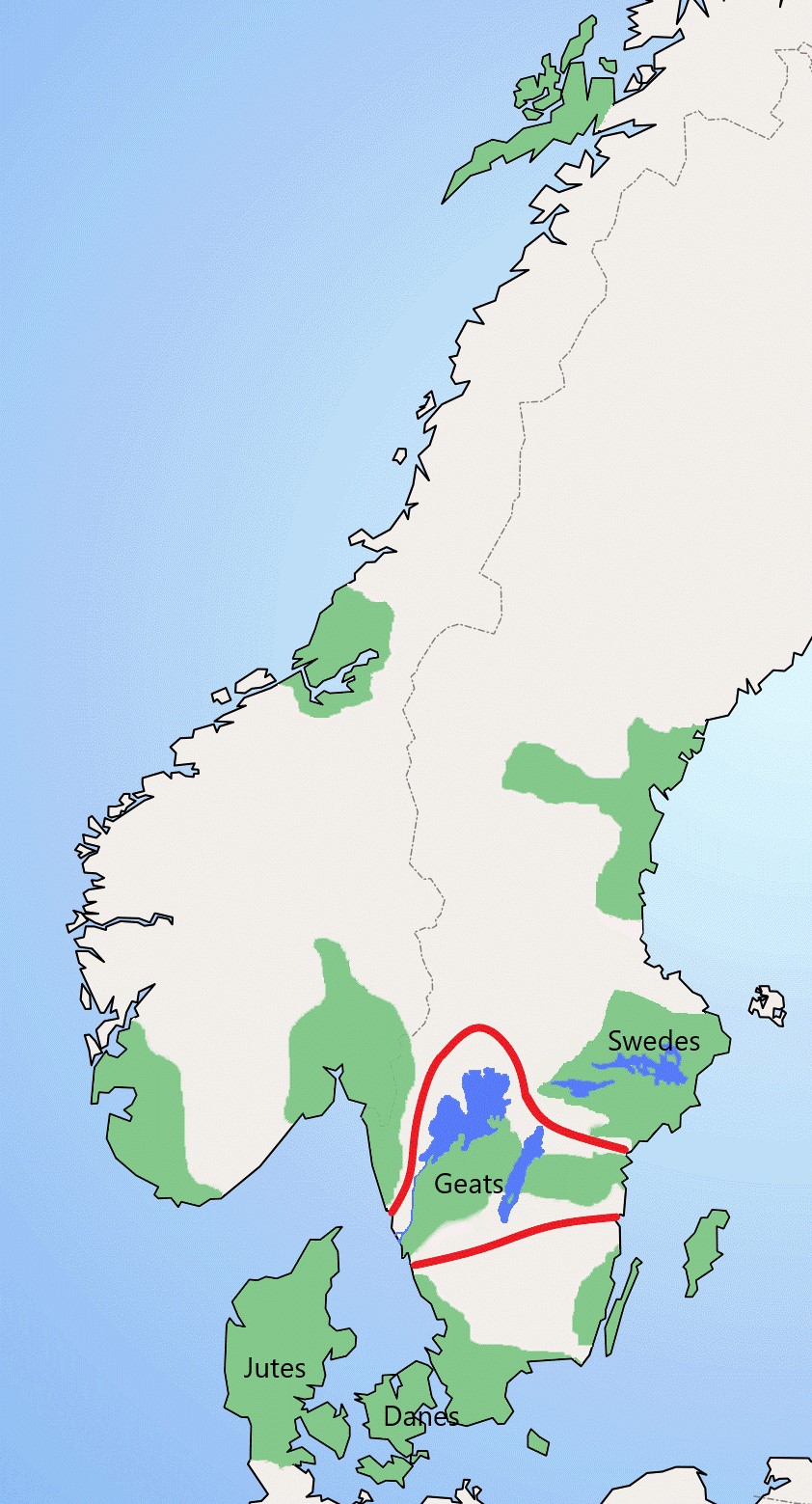|
Erik The Saint
Saint Erik ( 1125 - 18 May 1160), also called Eric IX or Erik Jedvardsson was King of Sweden from 1156 until his death in 1160. The ''Roman Martyrology'' of the Catholic Church names him as a saint memorialized on 18 May. He was the founder of the House of Erik, which ruled Sweden with interruptions from c. 1156 to 1250. Background As later kings from the House of Erik were consistently buried at Varnhem Abbey near Skara in Västergötland, Erik's family is considered to have Geatish roots like other medieval ruling houses in Sweden. Osteological investigations of Erik's remains suggest that he may have lived the last 10–15 years of his life in Västergötland rather than in Uppland where he died. On the other hand, the only manor he is known to have possessed is situated in Västmanland in Svealand. Eriksberg in central Västergötland has been suggested as the original family manor. Erik had a brother whose name began with a "J"; this brother has been identified with a Jo ... [...More Info...] [...Related Items...] OR: [Wikipedia] [Google] [Baidu] |
King Of Sweden
The monarchy of Sweden is centred on the monarchical head of state of Sweden,See the #IOG, Instrument of Government, Chapter 1, Article 5. by law a constitutional monarchy, constitutional and hereditary monarchy with a parliamentary system.Parliamentary system: see the #IOG, Instrument of Government, Chapter 1, Article 1. There have been kings in what now is the Sweden, Kingdom of Sweden for more than a millennium. Originally an elective monarchy, it became a hereditary monarchy in the 16th century during the reign of Gustav Vasa, though virtually all monarchs before that belonged to a limited and small number of political families which are considered to be the royal dynasties of Sweden. The official continuous count usually begins with the kings who ruled both Svealand and Götaland as one kingdom. Sweden's monarchy is amongst the oldest in the world, with a regnal list stretching back to the tenth century, starting with Eric the Victorious; the Swedish monarchy has, for the p ... [...More Info...] [...Related Items...] OR: [Wikipedia] [Google] [Baidu] |
Catholic Church
The Catholic Church (), also known as the Roman Catholic Church, is the List of Christian denominations by number of members, largest Christian church, with 1.27 to 1.41 billion baptized Catholics Catholic Church by country, worldwide as of 2025. It is among the world's oldest and largest international institutions and has played a prominent role in the history and development of Western civilization.Gerald O'Collins, O'Collins, p. v (preface). The church consists of 24 Catholic particular churches and liturgical rites#Churches, ''sui iuris'' (autonomous) churches, including the Latin Church and 23 Eastern Catholic Churches, which comprise almost 3,500 dioceses and Eparchy, eparchies List of Catholic dioceses (structured view), around the world, each overseen by one or more Bishops in the Catholic Church, bishops. The pope, who is the bishop of Rome, is the Papal supremacy, chief pastor of the church. The core beliefs of Catholicism are found in the Nicene Creed. The ... [...More Info...] [...Related Items...] OR: [Wikipedia] [Google] [Baidu] |
Östergötland
Östergötland (; English exonym: East Gothland) is one of the traditional provinces of Sweden (''landskap'' in Swedish) in the south of Sweden. It borders Småland, Västergötland, Närke, Södermanland and the Baltic Sea. In older English literature, the Latinized version ''Ostrogothia'' is also used. The corresponding administrative county, Östergötland County, covers the entire province and parts of neighbouring provinces. Heraldry From 1560, Östergötland was represented with two separate coats-of-arms seals until 1884, when the current one was granted. The coat of arms is represented with a ducal coronet. Blazon: " gules a griffin with dragon wings, tail and tongue rampant or armed, beaked, langued and membered azure between four roses argent." Geography From west to east, in the middle parts, extends the Östgöta Plain (''Östgötaslätten''). It is largely agricultural. In the southern part of the province, the terrain becomes marked by the south Swedish hi ... [...More Info...] [...Related Items...] OR: [Wikipedia] [Google] [Baidu] |
Inge The Elder
Inge the Elder ( Swedish: ''Inge Stenkilsson''; Old Norse: ''Ingi Steinkelsson''; died c. 1105–1110) was a king of Sweden. In English literature he has also been called ''Ingold''. While scant sources do not allow a full picture of his term of kingship, he is known to have led a turbulent but at length successful reign of more than two decades. He stands out as a devout Christian who founded the first abbey in Sweden and acted harshly against pagan practices. The kingdom was still an unstable realm based on alliances of noblemen, and Inge's main power base was in Västergötland and Östergötland; one of the earliest chronicles that mention his reign knows him as ''rex gautorum'', king of the Geats.Peter Sawyer, ''När Sverige blev Sverige''. Alingsås: Viktoria, 1991, p. 37. Biography Inge was the son of the former King Stenkil and a Swedish princess. Inge shared the rule of the kingdom with his probably elder brother Halsten Stenkilsson, [...More Info...] [...Related Items...] OR: [Wikipedia] [Google] [Baidu] |
Sverker I Of Sweden
Sverker the Elder (Old Swedish: ''Swærkir konongær gambli''; c. 1100 - 25 December 1156), also known as Sverker I, was King of Sweden from about 1132 until his murder. Of non-royal descent, he founded the House of Sverker, the rulers of which alternated with the rival House of Erik over the next century. Origins Sverker was a wealthy landowner from Östergötland. According to the Västgöta Law (c. 1240), his father's name was ''Cornube'', but according to the Icelandic ''Skáldatal'', his father's name was ''Kol''. A later pedigree has the filiation Kettil – Kol – Kornike (Cornube) – Sverker. He rose to power after the extinction of the House of Stenkil in the 1120s. The Danish prince Magnus Nielsen was acknowledged as king in Götaland for a while, although the extent of his actual power is not clear. However, Magnus's involvement in the civil strife in his homeland gave opportunities for Sverker to act. According to the partial account of Saxo Grammaticus, "the S ... [...More Info...] [...Related Items...] OR: [Wikipedia] [Google] [Baidu] |
Eric The Holy Of Sweden Torsgatan Sculpture 2012 Stockholm
The given name Eric, Erich, Erikk, Erik, Erick, Eirik, or Eiríkur is derived from the Old Norse name ''Eiríkr'' (or ''Eríkr'' in Old East Norse due to monophthongization). The first element, ''ei-'' may be derived from the older Proto-Norse ''* aina(z)'', meaning "one, alone, unique", ''as in the form'' ''Æ∆inrikr'' explicitly, but it could also be from ''* aiwa(z)'' "everlasting, eternity", as in the Gothic form ''Euric''. The second element ''- ríkr'' stems either from Proto-Germanic ''* ríks'' "king, ruler" (cf. Gothic ''reiks'') or the therefrom derived ''* ríkijaz'' "kingly, powerful, rich, prince"; from the common Proto-Indo-European root * h₃rḗǵs. The name is thus usually taken to mean "sole ruler, autocrat" or "eternal ruler, ever powerful". ''Eric'' used in the sense of a proper noun meaning "one ruler" may be the origin of ''Eriksgata'', and if so it would have meant "one ruler's journey". The tour was the medieval Swedish king's journey, when newly ele ... [...More Info...] [...Related Items...] OR: [Wikipedia] [Google] [Baidu] |
Blot-Sweyn
Blot-Sweyn (Swedish: ''Blot-Sven'') was a Sweden, Swedish king c. 1080, of disputed historicity, who was said to have replaced his Christians, Christian brother-in-law Inge I of Sweden, Inge as King of Sweden, when Inge had refused to administer the blót (pagan sacrifices) at the Temple at Uppsala. There is no mention of Sweyn in the regnal list of the ''Westrogothic law'', which suggests that his rule did not reach Västergötland. According to Swedish historian Adolf Schück he was probably the same person as Håkan the Red and was called the ''Blót Swain'' (a ''swain'' who was willing to perform the blót) as an epithet rather than a personal name. Becoming king The earliest source that deals with Blot-Sweyn's coming to power is the Icelandic legendary saga ''Hervarar saga'': However, Inge did not permit the people to follow the old ways, unlike his father Stenkil. The Swedes reacted strongly and asked Inge to either comply with the old traditions or abdicate. When Inge pro ... [...More Info...] [...Related Items...] OR: [Wikipedia] [Google] [Baidu] |
King Sverre's Saga
''Sverris saga'' is one of the Kings' sagas. Its subject is King Sverre Sigurdsson of Norway (r. 1177–1202) and it is the main source for this period of Norwegian history. As the foreword tells us, the saga in its final form consists of more than one part. Work first began in 1185 under the king’s direct supervision. It is not known when it was finished, but presumably it was well known when Snorri Sturluson began writing his ''Heimskringla'' in the 1220s since Snorri ends his account where ''Sverris saga'' begins. Thus the saga is contemporary or near-contemporary with the events it describes. The saga is obviously written by someone sympathetic to Sverre’s cause, but the strict demands of the genre ensure some degree of impartiality. Authorship and composition The first distinct part of the saga is called ''Grýla'' and describes the events until the aftermath of Sverre's first major victory at the Battle of Kalvskinnet (''slaget på Kalvskinnet'') outside Nidaros in 1 ... [...More Info...] [...Related Items...] OR: [Wikipedia] [Google] [Baidu] |
Svealand
Svealand (), or Swealand, is the historical core region of Sweden. It is located in south-central Sweden and is one of the three historical lands of Sweden, bounded to the north by Norrland and to the south by Götaland. Deep forests, Tiveden, Tylöskog, and Kolmården, separated Svealand from Götaland. Historically, its inhabitants were called , from which is derived the English 'Swedes'. Svealand consists of the capital region Mälardalen in the east, Roslagen in the north-east, the former mining district Bergslagen in the center, and Dalarna and Värmland in the west. It includes an extensive archipelago of thousands of small islands in Södermanland and Uppland and has lakeshores on the four largest lakes in the country. In the interior, there are several ski resorts in the southern parts of the Scandinavian Mountains. Two large rivers run through Svealand. Klarälven originates in Norway and enters lake Vänern through Värmland, whereas Dalälven runs from ... [...More Info...] [...Related Items...] OR: [Wikipedia] [Google] [Baidu] |
Västmanland
Västmanland ( or ) is a historical Swedish province, or , in middle Sweden. It borders Södermanland, Närke, Värmland, Dalarna and Uppland. Västmanland means "West Man Land" or, less literally, "The Land of the Western Men", where the "western men" () were the people living west of Uppland, the core province of early Sweden. Administration The traditional provinces of Sweden serve no administrative or political purposes (except sometimes as sport districts), but are historical and cultural entities. In the case of Västmanland the corresponding administrative county, Västmanland County, constitutes the eastern part of the province. The western part is in Örebro County where the municipalities of Hällefors, Lindesberg, Ljusnarsberg and Nora are located. Heraldry The coat of arms was granted in 1560. At the time, it featured one fire mountain, to represent the mine of Sala Municipality. Soon, their numbers were increased to three, to also symbolize the Lindesb ... [...More Info...] [...Related Items...] OR: [Wikipedia] [Google] [Baidu] |
Uppland
Uppland is a historical province or ' on the eastern coast of Sweden, just north of Stockholm, the capital. It borders Södermanland, Västmanland and Gästrikland. It is also bounded by lake Mälaren and the Baltic Sea. The name literally means ''up land'', a name which is commonly encountered in especially older English literaturer as ''Upland''. Its Latinised form, which is occasionally used, is ''Uplandia''. Uppland is often called called the province of "castles, ancient remains and runestones" and is famous for having the highest concentration of runestones in the world, with as many as 1,196 inscriptions in stone left by the Vikings. Many of its castles and places of historical interest include Drottningholm Palace, Skokloster Castle, Salsta Castle, the medieval Uppsala Cathedral, where many royals are buried, and Uppsala Castle. Famous people from the region include Ingmar Bergman, St. Bridget of Sweden, Carl Linnaeus, Anders Celsius and Gustav Vasa. It ... [...More Info...] [...Related Items...] OR: [Wikipedia] [Google] [Baidu] |
Geatish
The Geats ( ; ; ; ), sometimes called ''Geats#Goths, Goths'', were a large North Germanic peoples, North Germanic tribe who inhabited ("land of the Geats") in modern southern Sweden from antiquity until the Late Middle Ages. They are one of the progenitor groups of modern Swedes, along with the tribes of Swedes (tribe), Swedes and Gutes. The name of the Geats also lives on in the Provinces of Sweden, Swedish provinces of and , the western and eastern lands of the Geats, and in many other toponyms. The Swedish dialects spoken in the areas that used to be inhabited by Geats form a distinct group, ''Götamål''. Etymology The etymology of the name ''Geat'' (Old English ', from a Proto-Germanic *''Gautaz'', plural *''Gautōz'') is similar to that of ''Goths'' and ''Gutes'' (*''Gutô'', plural *''Gutaniz''). The names derive from Indo-European ablaut, ablaut grades of the Proto-Germanic word *''geutaną'', meaning "to pour". They have the literal meaning "they who pour their se ... [...More Info...] [...Related Items...] OR: [Wikipedia] [Google] [Baidu] |







